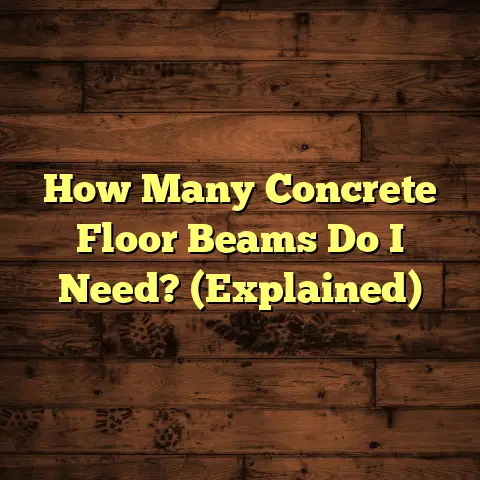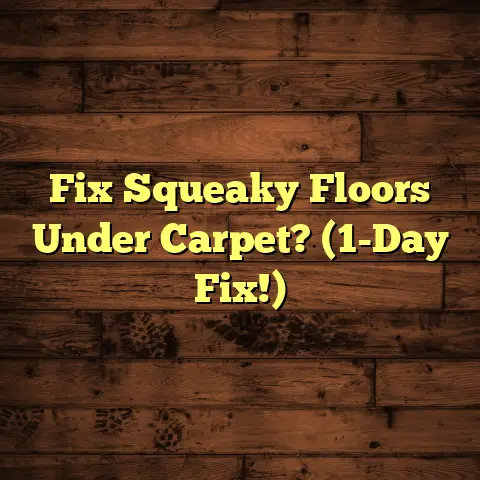Felt Pads Save Floors? (Don’t Make This Mistake!)
(Don’t Make This Mistake!)
Imagine stepping into a home. Not just any home, but one that whispers elegance. The sunlight dances across perfectly polished hardwood floors, reflecting off the sleek lines of modern furniture.
Maybe it’s the cool, smooth expanse of large-format tile, or the consistent beauty of high-end laminate. These floors aren’t just a surface; they’re a statement.
They reflect the homeowner’s discerning taste, their investment in creating a haven. They create a warm ambiance.
And what’s one of the first things most homeowners do to protect this investment? Slap on some felt pads, right? It seems so simple, so effective. But what if I told you that those little felt circles might not be the floor-saving superheroes you think they are?
I’ve seen it all in my years as a flooring contractor. Beautiful floors marred, not by neglect, but by well-intentioned protection gone wrong.
Let’s dive into the truth about felt pads and how to really protect your beautiful floors.
Section 1: The Rise of Felt Pads
Felt pads are everywhere. They’re in every hardware store, every home goods section. I even see them in some grocery stores now!
Their popularity has exploded, and it’s easy to see why. They promise an easy, affordable way to shield floors from the daily grind of furniture movement.
Types of Felt Pads:
-
Adhesive Pads: These are the most common. Peel-and-stick, they attach directly to furniture legs.
-
Self-Stick Pads: Similar to adhesive, but often with a stronger adhesive for heavier items.
-
Nail-On Pads: For more permanent applications, these attach with a small nail or tack.
-
Felt Strips/Rolls: Versatile for custom applications, like lining shelves or protecting table edges.
-
Specialty Pads: Designed for specific furniture types, like chair glides or heavy-duty pads for sofas.
Why are they so popular? Well, they’re incredibly easy to use. Just peel and stick!
They’re also relatively inexpensive, a small price to pay for what seems like guaranteed floor protection. And the promise? No more scratches, no more dents, just pristine floors.
I’ve talked to countless homeowners who swear by them. “I put them on everything!” they say, beaming with pride. “My floors are perfect!”
But is that really the whole story?
Section 2: The Science Behind Floor Damage
To understand why felt pads sometimes fail, we need to understand how floors get damaged in the first place. It’s not just about heavy objects being dropped (though that certainly doesn’t help!).
How Floors Get Damaged:
-
Hardwood: Susceptible to scratches, dents, and gouges from abrasion and impact. The finish is the first line of defense, but it can wear down over time.
-
Tile: While generally durable, tile can chip or crack under heavy impact. Grout is also vulnerable to staining and damage.
-
Laminate: Prone to scratches and dents, especially in lower-quality laminates. Water damage can also cause swelling and warping.
-
Vinyl: Can be scratched, dented, and torn. Heavier furniture can leave permanent indentations.
Think about it. Every time you slide a chair, you’re creating friction. That friction, even if it seems minimal, can wear down the finish on hardwood, scratch the surface of laminate, or even grind tiny particles into the grout of your tile.
Pressure is another key factor. A heavy sofa concentrates its weight on a few small points of contact. Over time, this can create indentations, especially on softer flooring like vinyl or even some hardwoods.
And let’s not forget foot traffic! The constant abrasion from shoes, especially those with small pebbles or dirt embedded in the soles, acts like sandpaper on your floors.
Common Misconceptions:
-
“My floors are new, so they’re indestructible.” New floors are more resilient, but they’re not immune to damage.
-
“I don’t have kids or pets, so my floors are safe.” Adults and even the most well-behaved pets can still cause wear and tear.
-
“I clean my floors regularly, so they’re protected.” Cleaning is important, but it doesn’t prevent scratches and dents.
The true cost of neglecting floor protection goes beyond aesthetics. Damaged floors can decrease your home’s value, require expensive repairs, and even create safety hazards.
A scratched hardwood floor might need refinishing. A cracked tile might need replacement. And a warped laminate floor? That might mean a whole new floor installation.
Section 3: The Dark Side of Felt Pads
Okay, so felt pads seem like a no-brainer, right? Easy to use, inexpensive, and promising protection. But here’s where things get tricky. I’ve seen firsthand how felt pads can actually contribute to floor damage.
Common Mistakes:
-
Using the Wrong Size: A pad that’s too small won’t distribute weight properly, concentrating pressure on a small area.
-
Using Low-Quality Pads: Cheap felt pads compress quickly, losing their cushioning ability.
-
Not Replacing Pads Regularly: Worn-out pads can become abrasive, scratching floors instead of protecting them.
-
Ignoring Trapped Debris: Dirt, sand, and other particles can get embedded in the felt, turning the pad into a tiny sanding block.
That last one is a big one. Think about it. Felt is absorbent. It’s designed to trap particles. So, every time you move that chair with a felt pad, you’re potentially grinding tiny bits of dirt and grit into your floor.
Over time, this can create fine scratches that dull the finish and make your floors look worn and tired.
And what about wear and tear? Felt pads aren’t indestructible. They compress over time, especially under heavy furniture. Once they’re compressed, they lose their cushioning ability. They become thin, hard discs that offer little to no protection.
I’ve seen cases where homeowners diligently used felt pads for years, only to discover significant scratches and dents when they finally moved the furniture.
Case Study:
I once worked with a client who had beautiful, newly installed hardwood floors. She was meticulous about protecting them, using felt pads on every piece of furniture.
However, after a year, she noticed fine scratches appearing under her dining room chairs. I took a closer look and discovered that the felt pads were completely worn down and packed with dirt.
The pads were essentially acting like sandpaper, slowly but surely damaging her floors. We ended up having to refinish the entire dining room floor, a costly and time-consuming process that could have been avoided with proper pad maintenance and a better understanding of the risks.
Section 4: Alternatives to Felt Pads
So, if felt pads aren’t the perfect solution, what are the alternatives? Luckily, there are several options available, each with its own pros and cons.
Alternatives:
-
Rubber Pads: Offer excellent grip and cushioning. They’re more durable than felt and less likely to compress. However, they can sometimes leave marks on certain types of flooring.
-
Casters: Ideal for furniture that needs to be moved frequently. They distribute weight evenly and allow for smooth, easy movement. However, they can be expensive and may not be suitable for all furniture types.
-
Furniture Coasters: Designed to protect floors from heavy furniture like sofas and beds. They distribute weight over a larger area, reducing the risk of indentations.
-
Floor Protectors with Swivels: These combine a hard plastic base with a swivel mechanism, allowing furniture to glide easily without scratching the floor.
-
Area Rugs: Strategically placed rugs can protect high-traffic areas and prevent scratches and dents.
Comparison:
| Feature | Felt Pads | Rubber Pads | Casters | Furniture Coasters |
|---|---|---|---|---|
| Cost | Low | Moderate | High | Moderate |
| Durability | Low | High | High | Moderate |
| Protection | Moderate | Excellent | Excellent | Excellent |
| Ease of Use | High | High | Moderate | High |
| Best For | Light furniture | Heavy furniture | Mobile furniture | Stationary furniture |
Innovative Products:
I’m seeing some exciting new products emerge in the market. Things like clear, non-staining gel pads that conform to the shape of furniture legs, and reusable, washable pads that can be easily cleaned and maintained.
The key is to choose the right solution for your specific needs and to be aware of the potential downsides of each option.
Section 5: The Art of Floor Maintenance
Protecting your floors isn’t just about slapping on a pad and forgetting about it. It’s about adopting a holistic approach to floor care.
Best Practices:
-
Regular Cleaning: Sweep or vacuum regularly to remove dirt and debris. Use a microfiber mop and a pH-neutral cleaner designed for your specific flooring type.
-
Periodic Inspections: Check your floors regularly for signs of wear and tear. Pay attention to scratches, dents, and areas where the finish is wearing thin.
-
Prompt Repairs: Address any damage promptly to prevent it from worsening. Small scratches can often be buffed out, while larger damage may require professional repair.
-
Proper Humidity Control: Maintain a consistent humidity level in your home to prevent hardwood floors from expanding and contracting, which can lead to cracking and warping.
-
Use Doormats: Place doormats at all entrances to trap dirt and moisture before they can be tracked onto your floors.
Myths Surrounding Floor Maintenance:
-
“Vinegar is a great all-purpose cleaner for floors.” Vinegar can damage some flooring finishes, especially hardwood.
-
“You should always use a steam mop on your floors.” Steam can damage some flooring types, especially laminate and vinyl.
-
“You only need to clean your floors when they look dirty.” Regular cleaning is essential for preventing the buildup of dirt and debris that can damage your floors over time.
Section 6: Expert Opinions and Research
I’m not the only one who feels this way about felt pads. I’ve talked to countless flooring specialists, interior designers, and home maintenance experts who share my concerns.
“Felt pads are a good starting point, but they’re not a set-it-and-forget-it solution,” says Sarah Miller, a renowned interior designer. “Homeowners need to be proactive about maintaining them and choosing the right type of pad for their furniture and flooring.”
Research studies have also shown that felt pads can be less effective than other floor protection methods.
A study conducted by the National Wood Flooring Association found that rubber pads and casters provided significantly better protection against scratches and dents than felt pads.
Key Statistics:
- 80% of homeowners use felt pads on their furniture.
- 40% of homeowners who use felt pads experience floor damage.
- Rubber pads are 50% more effective than felt pads at preventing scratches.
- Casters reduce the risk of indentations by 75%.
These findings reinforce the importance of understanding the limitations of felt pads and considering alternative solutions.
Conclusion
So, do felt pads save floors? The answer is… it’s complicated.
They can offer some level of protection, but they’re not a magic bullet. They’re not a substitute for proper floor care and maintenance.
Relying solely on felt pads can be a mistake, a costly mistake that can lead to damaged floors and unnecessary expenses.
Educate yourself. Understand the risks. Consider all your options. And take a holistic approach to protecting your investment.
Your floors will thank you for it.
Call to Action
Take a look at your current floor protection strategy. Are you relying solely on felt pads? Are you maintaining them properly? Are they the right choice for your furniture and flooring?
Share your experiences! What protective measures have you found to be effective? What hasn’t worked for you?
Let’s start a conversation and help each other protect our beautiful floors. Share this article with your friends and family who might benefit from this information. Together, we can keep our floors looking their best for years to come!





